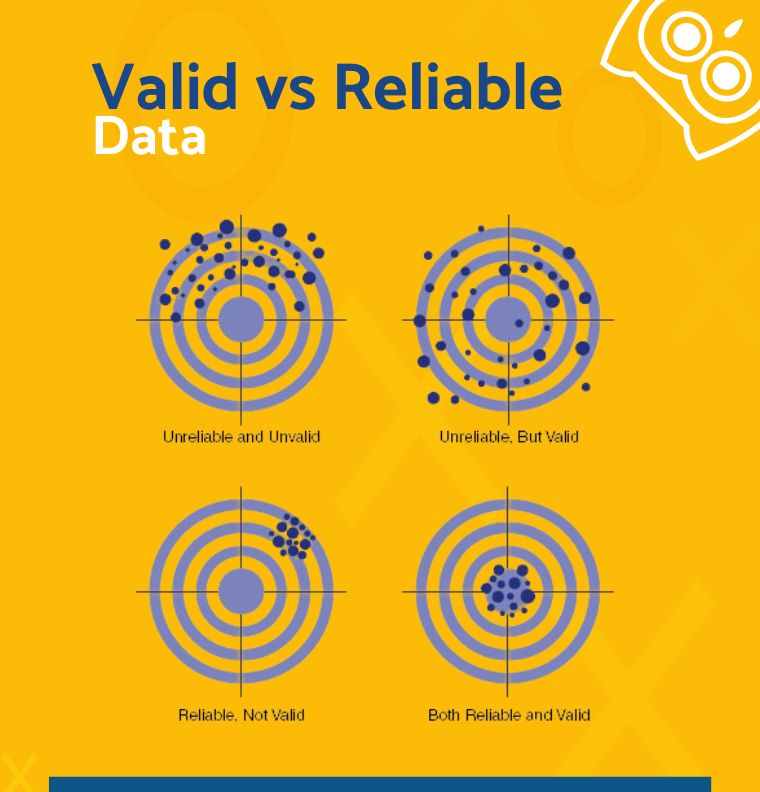Reliability vs. Validity in Research: The Essence of Credible Research
Table of contents
- 1 Understanding Reliability in Research
- 2 Understanding Validity in Research
- 3 Key Differences Between Reliability and Validity
- 4 The Role of Reliability and Validity in Research Design
- 5 Challenges and Considerations in Ensuring Reliability and Validity
- 6 Ensuring Excellence in Research Through Meticulous Methodology
The concepts of reliability and validity play pivotal roles in ensuring the integrity and credibility of research findings. These foundational principles are crucial for researchers aiming to produce work that contributes to their field and withstands scrutiny. Understanding the interplay between reliability vs validity in research is essential for any rigorous investigation.
The main points of our article include:
- A detailed exploration of the concept of reliability, including its types and how it is assessed.
- An in-depth look at validity, discussing its various forms and the methods used to evaluate it.
- The relationship between reliability and validity, and why both are essential for the credibility of research.
- Practical examples illustrating the application of reliability and validity in different research contexts.
- Strategies for enhancing both reliability and validity in research studies.
This understanding sets the stage for a more in-depth look at these important parts of the methodology. By explaining these ideas in more detail, we can have a deeper discussion about how to use and evaluate them successfully in different research settings. For better understanding and faster progress with your research, students can hire a college paper writer from sites like PapersOwl to get more information and help with defining these two concepts.
Understanding Reliability in Research
So, at first, let’s start with the reliability definition.
It measures how stable and consistent the results of a research tool are across a number of tests and conditions. It tells us how reliable the data we collected is, which, in turn, is important for making sure that the study results are valid.
There are several types of reliability crucial for assessing the quality of research instruments:
- Test-retest reliability evaluates the consistency of results when the same test is administered to the same participants under similar conditions at two different points in time.
- Inter-rater reliability measures the extent to which different observers or raters agree in their assessments, ensuring that the data collection process is unbiased and consistent across individuals.
- Parallel-forms reliability involves comparing the results of two different but equivalent versions of a test to the same group of individuals, assessing the consistency of the scores.
- Internal consistency reliability assesses the homogeneity of items within a test, ensuring that all parts contribute equally to what is being measured. This is closely tied to the concept of criterion validity, which evaluates how well one measure predicts an outcome based on other measures.
Methods for measuring and improving reliability include statistical techniques such as Cronbach’s alpha for internal consistency reliability, as well as ensuring standardized testing conditions and thorough training for raters to enhance inter-rater reliability.
Examples of reliability in research can be seen in educational assessments (test-retest reliability), psychological evaluations (internal consistency reliability), and health studies (inter-rater reliability).
Each context underscores the importance of reliable measurement as a precursor to assessing content validity (the extent to which a test measures all aspects of the desired content) and construct validity (the degree to which a test accurately measures the theoretical construct it is intended to measure). Both content validity and construct validity are essential components of overall validity, which refers to the accuracy of the research findings.
Understanding Validity in Research
In research, validity is a measure of accuracy that indicates how well a method or test measures what it is designed to assess. High validity is indicative of results that closely correspond to actual characteristics, behaviors, or phenomena in the physical or social world, making it a critical aspect of any credible research endeavor.
Types of validity include:
- Content validity, which ensures that a test comprehensively covers all aspects of the subject it aims to measure.
- Criterion-related validity, which is divided into predictive validity (how well a test predicts future outcomes) and concurrent validity (how well a test correlates with established measures at the same time).
- Construct validity, further broken down into convergent validity (how closely a new test aligns with existing tests of the same constructs) and discriminant validity (how well the test distinguishes between different constructs).
- Face validity, a more subjective measure of how relevant a test appears to be at face value, without delving into its technical merits.
Validity can be measured and ensured in a number of ways, such as through expert evaluations or by doing statistical calculations. They focus on how well the test or method matches up with theoretical expectations and set standards. Validity requires careful data collection, careful test design, and regular checks to see if the test is still relevant and accurately showing the intended constructs.
Examples of validity in research are abundant and varied. In educational testing, content validity is assessed to ensure that exams or assessments fully represent the curriculum they aim to measure. In psychology, convergent validity is demonstrated when different tests of the same psychological construct yield similar results, while predictive validity might be observed in employment settings where a cognitive test predicts job performance. Each of these examples showcases how validity is assessed and achieved, highlighting its role in producing meaningful and accurate research outcomes.
Key Differences Between Reliability and Validity

The key differences between reliability and validity lie in their focus and implication in research. Reliability concerns the consistency of a measurement tool, ensuring that the same measurement is obtained across different instances of its application. For instance, interrater reliability ensures consistency in observations made by different scholars. Validity, on the other hand, assesses whether the research tool accurately measures what it is intended to, aligning with established theories and meeting the research objectives. While reliability is about the repeatability of the same measurement, validity dives deeper into the accuracy and appropriateness of what is being measured, ensuring it reflects the intended constructs or realities.
The Role of Reliability and Validity in Research Design
The incorporation of reliability and validity assessments in the early stages of research design is paramount for ensuring the credibility and applicability of research outcomes. By prioritizing these evaluations from the outset, research writers can design studies that accurately reflect and measure the phenomena of interest, leading to more trustworthy and meaningful findings.
Strategies for integrating reliability and validity checks throughout the research process include the use of established statistical methods and the continuous evaluation of research measures. For instance, employing factor analysis can help in identifying the underlying structure of data, thus aiding in the assessment of construct validity. Similarly, calculating Cronbach’s alpha can ensure the internal consistency of items within a survey, contributing to the overall reliability of the research measures.
Case studies across various disciplines underscore the critical role of reliability and validity in shaping research outcomes and influencing subsequent decisions. For example, in clinical psychology research, the use of validated instruments to assess patient symptoms ensures that the measures accurately capture the constructs of interest, such as depression or anxiety levels, which in turn supports the internal validity of the study. In the field of education, ensuring the interrater reliability of grading rubrics can lead to fairer and more consistent assessments of student performance.
Moreover, the application of rigorous statistical methods not only enhances the reliability and validity of the research but also strengthens the study’s foundation, making the findings more compelling and actionable. By systematically integrating these checks, researchers can avoid common pitfalls such as measurement errors or biases, thereby ensuring that their studies contribute valuable insights to the body of knowledge.
Challenges and Considerations in Ensuring Reliability and Validity
Ensuring reliability and validity in research is crucial for the credibility and applicability of research results. These principles guide how to design studies, collect data, and interpret findings to ensure that their work accurately reflects the underlying constructs they aim to explore.
Ensuring Reliability
To ensure reliability, researchers must focus on creating consistent, repeatable conditions and employing precise measurement tools. The test-retest correlation is a fundamental method where writers administer the same test to the same subjects under similar conditions at two different times. A high correlation between the two sets of results indicates strong reliability.
For example, in a study measuring the stress levels of first responders, using the same stress assessment tool at different intervals can validate the tool’s reliability through consistent scores.
Another strategy is ensuring reliable measurement through inter-rater reliability, where multiple observers assess the same concept to verify consistency in observations. In environmental science, when studying the impact of pollution on local ecosystems, different researchers might assess the same water samples for contaminants. The consistency of their measurements confirms the reliability of the methods used.
Ensuring Validity
Ensuring validity involves verifying that the research accurately measures the intended concept. This can be achieved through careful questioning in research formulation, selecting valid measurement instruments, and employing appropriate statistical analyses.
For instance, when studying the effectiveness of a new educational curriculum, researchers might use standardized test scores to measure student learning outcomes. This approach ensures that the tests are a valid measurement of the educational objectives the curriculum aims to achieve.
Construct validity can be enhanced through factor analysis, which helps in identifying whether the collected data truly represent the underlying construct of interest. In health research, exploring the validity of a new diagnostic tool for a specific disease involves comparing its results with those from established diagnostic methods, ensuring that the new tool accurately identifies the disease it claims to measure.
Considerations for Specific Research Methods
Different research methods, such as qualitative vs. quantitative research, require distinct approaches to ensure validity and reliability. In qualitative research, ensuring external validity involves a detailed and transparent description of the research setting and context, allowing others to assess the applicability of the findings to similar contexts.
For instance, in-depth interviews exploring patients’ experiences with chronic pain provide rich, contextual insights that might not be generalizable without a clear articulation of the setting and participant characteristics.
In quantitative research, ensuring the validity and reliability of collecting data often involves statistical validation methods and reliability tests, such as Cronbach’s alpha for internal consistency.

Ensuring Excellence in Research Through Meticulous Methodology
In summary, the fundamental takeaways from this article highlight the paramount importance of ensuring high reliability and validity in conducting research. These principles are not merely academic considerations but are crucial for the integrity and applicability of research findings. The accuracy of research instruments, the consistency of test scores, and the thoughtful design of the methods section of a research paper are all critical to achieving these goals. For researchers aiming to enhance the credibility of their work, focusing on these aspects from the outset is key. Additionally, seeking help with complex research design or specialized analysis from an online research paper writing service can provide valuable insights and support, ensuring that studies not only adhere to the highest standards of reliability and validity but also contribute meaningful knowledge to their respective fields.







